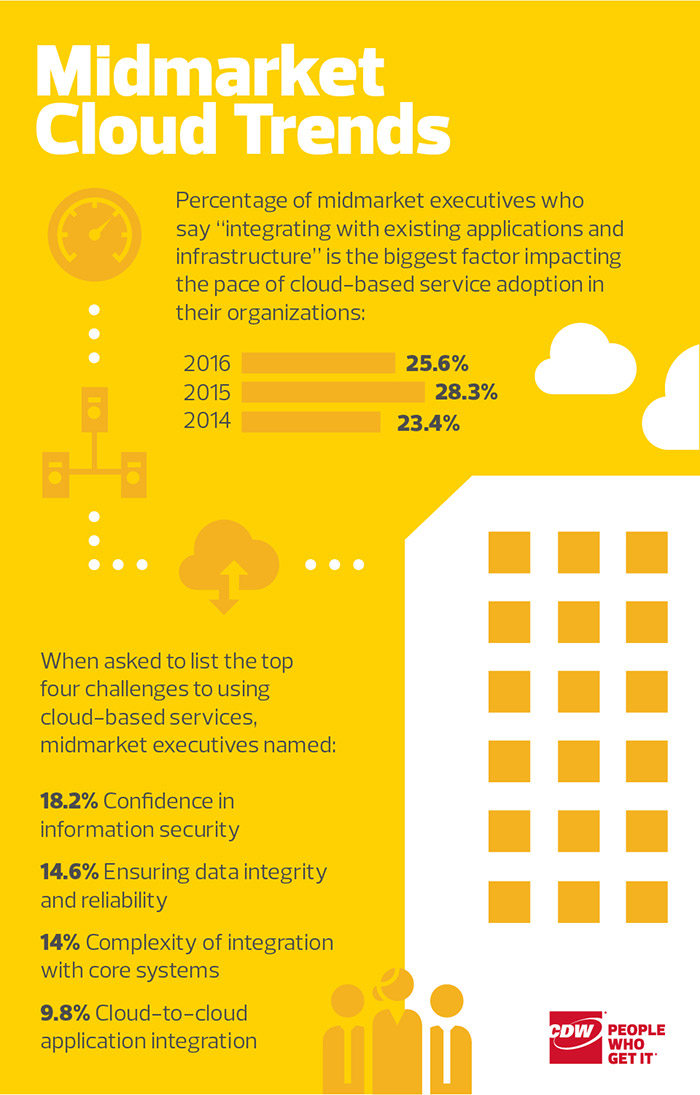4 Ways to Simplify the Move to Cloud-Based Services
Although midmarket executives foresee a future in the cloud, the move to hosted services doesn’t come without challenges.
According to a Deloitte survey of 500 midmarket executives, nearly 40 percent of respondents believe cloud infrastructure has the highest potential to produce major productivity gains for their organizations.
But executives struggle to see the full impact of the cloud. They report that top challenges to using cloud services include:
- Complexity of integration with core systems
- Cloud-to-cloud application integration
- Ensuring data integrity and reliability
- Confidence in information security
Experts offer these four tips for overcoming those hurdles to cloud service adoption:
1. Don’t Rush into Cloud Adoption
Dan Conde, an analyst with Enterprise Strategy Group, says that because midmarket businesses don’t face the same bureaucratic hurdles as large businesses, there’s little to stop them from signing up for many cloud-based services in a short time frame. But this practice can be a mistake.
“If you have too many cloud apps, you get a huge tangle of apps that are not well coordinated or integrated,” Conde says. “It’s worthwhile to step back and see if there is a good suite that provides most of the functions you need.”
Jeff Kato, senior analyst with the consulting and analysis firm Taneja Group, agrees that proper planning is essential.
“I think a lot of people don’t think through up front how they want different applications to connect architecturally,” he says. “It’s only after the fact that they realize they’ve lost functionality.”
2. Consider the Compatibility of Cloud Applications
Although cloud connectors have gained traction, Kato warns that many cloud services don’t automatically integrate and share data with existing systems.
The disconnect doesn’t stop there: “Cloud-to-cloud connections are less prevalent because app providers want you to stay on their platform,” Kato says, adding that a lack of standard data exchange mechanisms further complicates matters.
Chris Nguyen, group product marketing manager at Adobe, recommends that businesses also explore whether a cloud platform is extensible and open.
“Are they able to tie in to the different types of web services that are required for your experiences or for any of your other applications?” he asks. “That’s really important because you don’t want to be caught in a closed environment.”

SOURCE: Deloitte, "Technology in the mid-market—Taking ownership," August 2016
3. Establish Your Data Availability Needs
Beyond determining how well cloud services will integrate with each other and with on-premises applications, organizations should consider whether the platforms at hand offer adequate access to their business data.
“If you need real-time access to trading information on the stock market, or something that’s mission critical, having that information on the cloud might not necessarily be as effective as if it were retained locally,” says Ryan Martin, senior analyst with ABI Research. “The reason is that you have to pipe that data back and forth each time you want to query it or call the data or do an event log.”
4. Maintain Security Standards
Finally, Adobe’s Nguyen advises decision-makers to ensure their top-choice cloud service meets the levels and guarantees of security mandated by the company.
“Not only from a service-level-agreement perspective and uptime perspective, but also do they meet all the industry-specific security requirements? Do they follow industry and accounting standards?” he asks. “You want to make sure they’re secure in that sense.”









